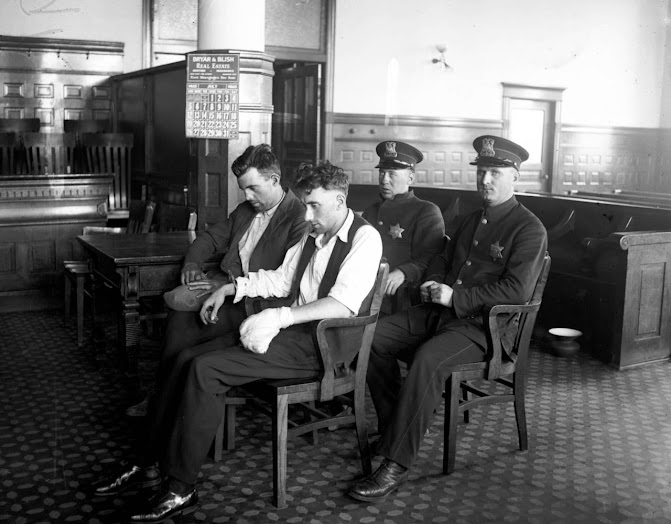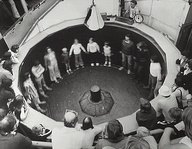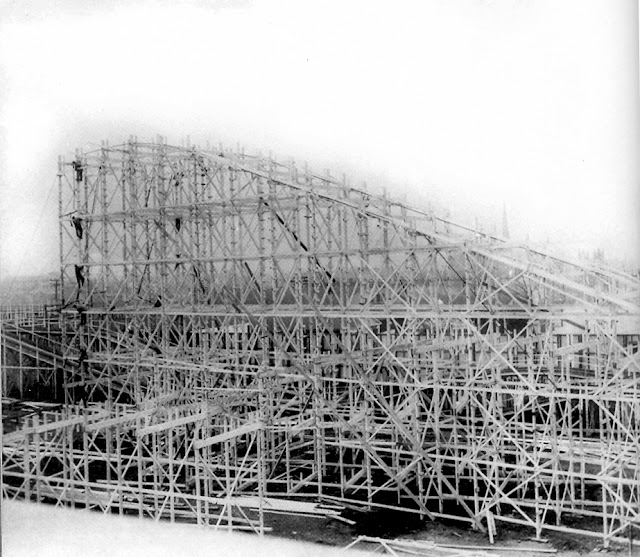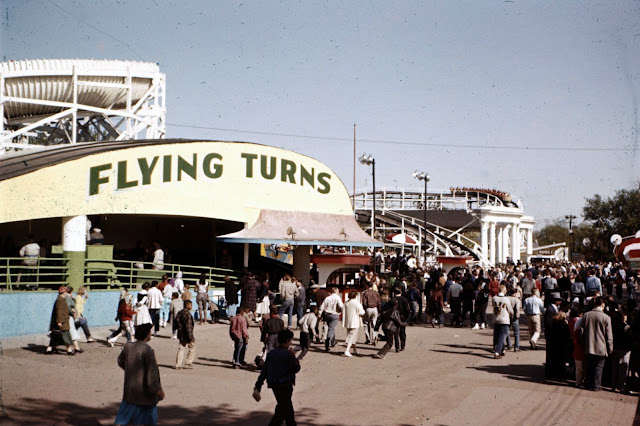In the early 1900s, when Cook County Jail was on Dearborn and Hubbard Streets, a nearby restaurant would supply 25 to 50 meals daily to inmates who could afford them.
The eatery was known as the "Noose Coffee Shop," located at 66 West Hubbard Street, across the alley from the Criminal Courts Building and Cook County Jail. The Noose was the popular lunch spot and hangout for reporters, attorneys, and other habitués of the Criminal Courts Building in the 1920s.
 |
| You can see the Noose Coffee Shop's location next to the Criminal Courts Building. A Google Street Maps Image. |
Restaurant owner Joe Stein supplied condemned prisoners with their last meal eaten in their death cell on the evening before their hanging. The County Jail reciprocated with photographs, some autographed, of famous local and national criminals. Joe lined the restaurant's walls with those photographs and soon got the nickname Joe's 'Gallery of Crime.' Criminals were hung in the alley between the courthouse and the adjacent Cook County Jail.
FROM THE GALLERY OF CRIME, MY FAVORITE CRIME STORIES.
The photographs below are not the pictures from Joe Stein's Restaurant.
Among the hundreds of original photographs on the restaurant walls was a picture of the tough prosecutor, Assistant State's Attorney William H. McSwiggin. By the age of 26, he had won seven death penalties in under eight months. Despite prohibition and McSwiggin's lawman status, on April 27, 1926, McSwiggin and his friend Tom "Red" Duffy went for a drink at "The Pony Inn," 5613 West Roosevelt Road in Cicero. Other mobsters were present at the tavern. A car stopped nearby, and occupants got out and sprayed them and other gangsters with machine gunfire. McSwiggin, Duffy, and a gangster named Jim Doherty were hit. Gang leader William "Klondike" O'Donnell's car sped McSwiggin & Doherty to the hospital, but both died en route.
 |
| William McSwiggin presented his plea in court to hang Anselmi and Scalise. |
Al Capone's gang was suspected, but O'Donnell's and Capone's gang were at odds with each other then, so McSwiggin was thought to be a mere bystander.
"Terrible Tommy" O'Connor escaped from the Criminal Courts Building in December 1921, only a day before he was to have been executed by hanging.
 |
| "Terrible Tommy" O'Connor |
O'Connor flew under the police radar for several years. He was up to no good in those early years; he just never got caught. Jimmy Cherin and a fellow partner in crime hung around a saloon operated by Jimmy's father, Dominick. The bar was a place where stolen goods could be fenced and was the favorite watering hole for some of Chicago's criminals.
Here, Tommy and Jimmy learned how to steal cars and commit other crimes. Tommy was known to have an explosive temper. On one occasion, he believed his mother was overcharged for some meat, so he chopped off the butcher's thumb. Tommy soon developed a reputation as a "cold-blooded killer" and acquired the moniker "terrible."
O'Connor was arrested for murder in 1921. Numerous accounts then refer to unspecified "shady court dealings" that saw O'Connor released. Chicago in the 1920s was notoriously corrupt. Police, judges, and politicians were on the take, so the notion of an accused murderer dodging justice was an unremarkable occurrence.
But O'Connor's freedom was short-lived. Somebody thought justice had been perverted and dispatched detective Patrick O'Neill to arrest O'Connor at his sister's Washtenaw Avenue house. There was an exchange of gunfire, and Officer O'Neill was hit and later died of his wounds.
O'Connor escaped out of the back of the house but was later arrested in St. Paul, Minnesota, after making a drunken nuisance of himself. He was hauled back to Chicago, tried, and found guilty of killing the police officer. The sentence was death by hanging, to be carried out in the middle of December 1921.
Four days before his date with the executioner, a prison guard was walking past O'Connor's cell when the inmate called him over. O'Connor's cellmate reached through the bars and put a headlock on the guard while Tommy took his keys and gun. They bound and gagged the guard, ran into the prison yard, and climbed over a 20-foot wall.
Another version of the breakout is that O'Connor got a gun that was smuggled into the prison hidden in a sandwich. This version has O'Connor and four or five other prisoners overpowering several guards before escaping.
Whatever the correct story, this is when the legendary Chicago lawyer Harry J. Busch met Terrible Tommy. At the time, a law school student, Busch, was driving in the neighborhood of the Cook County Jail. More than 70 years later, Busch recalled what happened after a man jumped onto his car's running board: "Suddenly the isinglass (heavy plastic) is ripped open and in comes Tommy with his cannon. He said, 'Drive like hell, you SOB, or I'll blow your brains out! I'm Tommy O'Connor!' I drove!"
Busch deliberately crashed his car into a factory wall. O'Connor scrambled out of the wreckage and was last seen legging it down the street. And that was literally the last time he was seen.
A $3,000 reward ($46,600 today) was offered for information leading to O'Connor's arrest, but it was not enough to shake loose any tips. Hundreds of police searched for the fugitive, but he was never found.
Stories appeared frequently about sightings. He was in California; no, it was Texas. He had joined the Irish Republican Army and been killed in a shootout; no, he'd died of tuberculosis. He was robbing banks in Canada; no, he had bought a pub in Limerick, Ireland.
There is a headstone in Worth, Illinois, a suburb of Chicago, with the name Tommy O'Connor on it. The date of death is given as 1951.
Chicago's famous Timothy "Big Tim" D. Murphy, a popular labor leader in 1921, was charged with organizing the theft of $400,000 ($6,211,000 today) from a Pullman mail train at Chicago's Union Station in August 1920. Although he was released on a $30,000 bond ($417,000 today). Judge Kenesaw Mountain Landis eventually convicted and sentenced Murphy to seven years in Leavenworth Penitentiary in Kansas.
Murphy was involved with armed robberies, labor racketeering, he had control of the railroad, laundry, and dye workers unions. His murder was never solved, though there were plenty of suspects. Some believed that the gunmen were associated with the rival, Mossy Enright, who was behind it; others believed Murray "The Camel" Humphreys was behind it, while others thought John "Dingbat" O'Berta could have been the culprit.
On May 6, 1922, Murphy, Cornelius Shea, and six other labor leaders were arrested and charged with the murder of a Chicago police officer. On May 24, the state asked for nolle prosequi ("to be unwilling to pursue"), and the court agreed to withdraw the indictments. A new indictment was returned against Murphy and the others in August, but the state also withdrew this second indictment.
 |
| (L to R) Murphy, Fred Mader, John Miller, and Cornelius Shea during their murder trial in 1922. |
Big Tim was a mentor to another politician/mobster, John "Dingbat" O'Berta. O'Berta married Big Tim's wife some months after his death. O'Berta himself was killed in one of Frank McErlane's oneway rides. In a twist of fate, O'Berta was buried near Big Tim, and when their wife Flo died, she was buried in a grave between them.
When Murphy answered his front doorbell at 2525 West Morse Avenue, Chicago, on the night of June 26, 1928, there was nobody there. Just as he stepped out to look down the street, a gunman blasted him in the head with a shotgun from a car. He died instantly.
On April 3, 1924, 23-year-old Beulah May Annan, Chicago's "prettiest slayer," shot her lover and coworker, Harry Kalstedt, in her South Side apartment at 817 East 46th Street, Chicago, while her husband, Al, was at work.
According to the report published in the Chicago Daily News the following day, Annan told Assistant State's Attorney Roy Woods she "danced to the tune of jazz records a passionate death dance, with the body of the man she had shot and killed."
The dramatic crime and subsequent press coverage that focused on Annan's "most striking appearance" turned her into a celebrity — and later an inspiration. Chicago Tribune crime reporter Maurine Watkins, who covered Annan and other women accused of murder in 1924, adapted her experiences into the play and later the musical "Chicago." Annan inspired the character Roxie Hart.
Much of the report came directly from Annan herself. She held court at the Harrison Street Police Station, answering all questions and waxing poetic about love.
"I didn't love Harry so much — but he brought me wine, made a fuss over me, and thought I was pretty," she told reporters. "I don't think I ever loved anybody very much. You know how it is — you keep looking and looking all the time for someone you can really love."
Kalstedt, who worked with Annan at a laundromat, invited himself and two quarts of wine over to Annan's apartment around 12:30 pm, she said.
"We drank all of it and began to quarrel. I taunted Harry with the fact that he had been in jail once, and he said something nasty back to me. Seems like we just wanted to make each other mad — and to hurt each other," Annan said.
In her rage, Annan called Kalstedt a name, her "magnolia-white skin flushing and paling as she recited her narrative of death," the paper reported. Kalstedt told her, "You won't call me a name like that," and he headed straight for the bedroom.
According to Annan, Kalstedt could only be going after one thing: a gun. Though usually tucked under a pillow, the gun sat on the bed in plain sight.
"I ran, and as he reached out to pick the gun up off the bed, I reached around him and grabbed it. Then I shot. They say I shot him in the back, but it must have been sort of under the arm," she recalled.
Kalstedt fell back against the wall. The record playing "Hula Lou" came to a stop "as the man in the bedroom breathed his last," the paper said.
Annan told reporters she couldn't stand the silence and restarted the record. After washing the blood off her hands, she took a washcloth to Kalstedt's face and kissed him. "Then I went back and started the record over again."
The shot, the paper said, was fired around 2 pm, but Annan didn't call for help until after 5 pm. "I just kept going back and forth between the living room and the bedroom, where Harry's body lay, and playing the phonograph," she said.
It wasn't until Annan's husband returned home that the police were finally called — and the media circus began.
Maurine Watkins, a Tribune reporter, was sent to the coroner's inquest at a South Side funeral home. Watkins painted a picture for Tribune readers:
"They say she's the prettiest woman ever accused of murder in Chicago — young, slender, with bobbed auburn hair; wide-set, appealing blue eyes; tip-tilted nose; translucent skin, faintly, very faintly, rouged, an ingenuous smile; refined features, intelligent expression — an 'awfully nice girl' and more than usually pretty."
Her lawyer, W.W. O'Brien, stated that self-defense would be her plea. The statements made at the police station would be repudiated as having been made under duress when intoxicated.
On May 24, 1924, a verdict of not guilty was recorded.
NOTE: Only twenty-one days from the crime to a court case decision.
A day after Beulah's acquittal, Al Annan, who had stood by his wife throughout the trial and who had spent a significant amount of money on her defense, got the news that his wife was leaving him. "He is too slow," Beulah explained.
Beulah May Annan died of tuberculosis in a Chicago sanatorium in 1928, four years after her acquittal on charges of murder.
The Drake Hotel Bandits. Fifty-year-old Frank Rodkey was shot to death at 3:30 pm in the Chicago's Drake Hotel office by one of five bandits who held up the place with shotguns. Eric Nelson and Ted "Tex" Court, two of the bandits, were killed by Lincoln Park Police Officers. Two others, Joseph W. Holmes, 25, and Jack (J.W.) Wood was captured and, on August 1, 1925, turned over to the sheriff on indictment. The fifth bandit, Wm. Wasil Marks (aka Mulenchuck, Melney) escaped the 28th district police station on October 10, 1925, and was at large until August 12, 1938, when he was arrested in Santa Barbara, California. Judge Hopkins sentenced Holmes and Woods to hang on December 11, 1925. Holmes and Woods were hanged at Cook County Jail on February 13, 1926.
 |
Drake Hotel Bandits Joseph Holmes, 25, left, and Jack Wood wearing a vest in 1925. Both Holmes and Wood confessed their involvement in the July 29, 1925, daylight holdup of the Gold Coast neighborhood's Hotel.
|
On May 21, 1924, a 14-year-old boy, Robert Emanuel "Bobby" Franks, was murdered by two young men, Nathan Leopold and Richard Loeb, both from wealthy and socially established Jewish families, simply to commit the perfect crime.
 |
| Robert Emanuel "Bobby" Franks |
At their trial, the famous Clarence Darrow conducted a defense based on psychological testimony and captured the nation's attention.
The two were indicted on June 5, 1924.
With the Leopold and Loeb case, the attention of the nation and world was once again focused on Chicago because of a murder. The circumstances of the crime involved the murder of a young boy, Bobby Franks, by Nathan Leopold and Richard Loeb, young men from wealthy Jewish families who said they killed their 14-year-old victim, whom they didn't know, because they wanted to commit the perfect, motiveless crime. The case quickly became internationally famous.
Although their plans to conceal their identities and collect a hefty ransom of $10,000 ($162,500 today) were elaborate and intricate, Leopold and Loeb were caught almost immediately because Nathan Leopold dropped a pair of glasses near to where the body of Bobby Franks had been left.
 |
| Nathan Leopold's Glasses |
The glasses had a special patented spring for the expensive horned rim frame and were only sold in one place in Chicago. It was found that only three people, including Nathan Leopold, purchased these glasses. Once in custody, Leopold and Loeb showed no remorse and confessed in great detail to the crime, both to the authorities and the press.
 |
| Bobby Franks was found beneath the culvert at 121st Street and the Pennsylvania Railroad tracks. Bobby was the son of millionaire Jacob Franks of 5052 South Ellis Avenue, Chicago. |
Their separate confessions (Leopold and Loeb) are consistent in their description of the details of the crime, except that each claimed the other actually committed the blows that killed Bobby Franks. In addition to their confessions to authorities, Leopold and Loeb made many incriminating statements to the press. They described their plans to commit this crime and their elaborate self-justifications for the murder, including the invocation of German philosophers, such as Friederich Neitzche.
Their friendship had been marked by fantasies and delusions of grandeur, highly ritualized games with elaborate plots and counterplots, and the planning and carrying out of previous criminal activities together. Their friendship also had overtones of homosexuality. Several books have been written about the case, and at least four feature films have been based on the circumstances of the crime.
Both were sentenced on September 10, 1924, to life in the Joliet Penitentiary in Illinois. In 1925, when the new Stateville Correctional Center, a maximum-security state prison for men in Crest Hill, Illinois, opened in 1925, Leopold and Loeb were transferred. Leopold and Loeb founded the Stateville Correspondence School. Richard Loeb was killed by another inmate.
Being Sicilians, Alberto Anselmi and Giovanni Scalise find employment with the gangs at Taylor Street, the area known as Little Sicily. The Genna Family ran the roost at the time on Taylor Street. They are in constant battle with the Northsiders, making and peddling rotgut booze, run by the formidable Dean O'Banion. Anselmi and Scalise make an odd couple at that. Scalise has one eye that deviates from the other, and Anselmi is almost twice Scalise's age. They both share a common trade, as both are cold-blooded Sicilian hitmen.
 |
| Alberto Anselmi and Giovanni Scalise |
On June 13, 1925, Anselmi, Salise, and Mike Genna are being driven around by another unknown hood in a big, flashy automobile. They had moments earlier been in a shootout with the Northsiders and had injured Moran and Drucci.
Police also out on the cruise got wind of the gang fight, immediately identified Mike "The Devil" Genna, and followed the gangster car. Police also think they recognized the fourth man in the car at the wheel, and this man was possibly identified as Samuel Amatuna, "the Beau Brummel" of gangland.
The driver of the gangster car becomes aware of the pursuit and guns the engine. The police also press on the gas. At this moment, Mike talks loudly in Sicilian and gives instructions for what will happen. He tells Anselmi and Scalise to grab the weapons on the car's floor. They consisted of two repeating shotguns and four sawed-off shotguns.
Anselmi and Scalise were tired of Amatuna and the Genna gang and received attractive offers elsewhere.
The police following them were Policemen Charles B. Walsh, Harold F. Olsen, Michael J. Conway, and Willam Sweeney.
The gangster car was now going 73 miles an hour at 59th street when a truck swerved in front of them, causing Genna's driver to hit the brakes, causing a spin, and slam his car into a lamp post. Police get out, exclaiming, "Hey, what's the idea?"
The Genna party answers their questions with a volley of gunshots from a repeating shotgun.
Policeman Olsen is hit in the jaw by the slugs and crumples to the floor. Patrolman Walsh is the next hit in the chest by buckshot. Sweeney and Conway return fire at Genna, Anselmi, and Scalise. Mike Genna's gun jams.
Genna, the unknown driver, Scalise, and Anselmi make a run for it. The unidentified fourth man is gone. Genna, Scalise, and Anselmi run into an alley running north and south between Western and Artesian Avenues. Scalise and Anselmi turn into a passageway of a house at 5941 South Artesian Avenue. Genna, tired of running, stops, turns to face Sweeney, levels his shotgun, pulls the trigger, and "Click," no bullet. Sweeney returns fire and fatally hits Genna in the leg, causing him to stumble after his companions.
Genna jumps through the basement window of a nearby home. Officer Sweeney follows, and two policemen (one retired) join Sweeney. They enter the basement and fire at Genna lying on the floor. He has a blue steel Spanish .38 in his hands. He fires before falling back. He has a severed artery in the leg from the first bullet by Sweeney. Before he dies, Mike Genna kicks the ambulance driver sent to take him to Englewood hospital in the face exclaiming, "Take that, you son of a bitch."
Police Officers Olsen and Walsh die from their wounds. Anselmi and Scalise ducked into a store but were later captured by police. Anselmi and Scalise are roughed up by the police, who are angered at the murders of their brethren. Slain police officer Harold Olsen's brother (John Olsen), also a policeman, goes to the station and wants to kill his brother's murderer, but he is talked out of it.
Three trials, first headed by McSwiggin, the hanging prosecutor, are achieved to try and hang or imprison Anselmi and Scalise.
Anselmi talked with his hands through an interpreter during the trials; he speaks no English. John Scalise spoke in broken English. All claim that they would never have been shot if they knew they were policemen. Then Scalise puts the blame on the death of Mike Genna as being the one who fired first.
The first trial was for the murder of policeman Olsen, and they were both sentenced to 14 years for manslaughter.
During their time in prison, Scalise and Anselmi feared for their lives. They are beaten up, and Scalise is almost poisoned. He finds the food tastes a little off and tells the guard. They send the food to be analyzed by a chemist and discover cyanide, enough to kill a couple of men in his spaghetti and beans.
In the second trial for the murder of policeman Walsh, they were both acquitted.
The Supreme Court later orders a new trial on the killing of Policeman Olsen. Scalise and Anselmi are both found not guilty and are immediately set free.
Their lawyer's defense was, in essence, that "If a policeman tries to kill you, you can, in turn, kill him in self-defense."
By Rupert John Taylor
Edited by Dr. Neil Gale, Ph.D.























































































































































































































































































